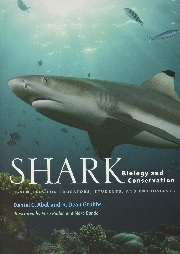Shark Biology and Conservation: Essentials for Educators, Students, and Enthusiasts

Daniel C. Abel and R. Dean Grubbs
Johns Hopkins University Press, £36.99
When reading Shark Biology and Conservation, it’s hard not to be infected by the authors’ enthusiasm for elasmobranchs. Abel and Grubbs have been teaching together for over 25 years, and the book grew out of an annual undergraduate field course. It therefore starts with the basics, even including some of the exercises they set for their students, then goes on to give a broad overview of shark physiology, behaviour and ecology.
The book not only works to dispel some myths held by the wider public of sharks as killers, but also held by those of us who already care about sharks yet know very little about them. The average shark is not grey, fast swimming and found on the coastline, but small, brown and living in the deep ocean. The 1,200 species of shark and ray range from the dwarf lantern shark, measuring just 20cm, to the 18m-long whale shark. Their body plans and ecology are just as varied, as this book explores.
Although conservation and human impacts make up just two of the 12 chapters, this is perhaps where the most striking information lies. A thorough overview of fisheries tells us, for example, that longlines can be 100km long with over a thousand hooks. However, longlining can actually be relatively ‘clean’ compared to other fishing methods, in that they often produce lower levels of bycatch. Sadly, sharks are among the bycatch in most types of fishery, and this has sometimes caused alarming population declines.
A particular problem comes in the deep ocean, where species tend to have slow life histories. Even if the fisheries’ target species are being caught sustainably, the sharks caught as bycatch may have gestation times of up to two years and produce fewer than ten pups. The life histories that have served sharks well for their 400-million-year evolutionary history means that populations are slow to recover from the barrage of challenges that humans are throwing at them.
Overall, the informal style of the prose makes this book approachable for students as well as anyone who wants to know more about these fascinating creatures.
Dr Rebecca Nesbit MRSB


